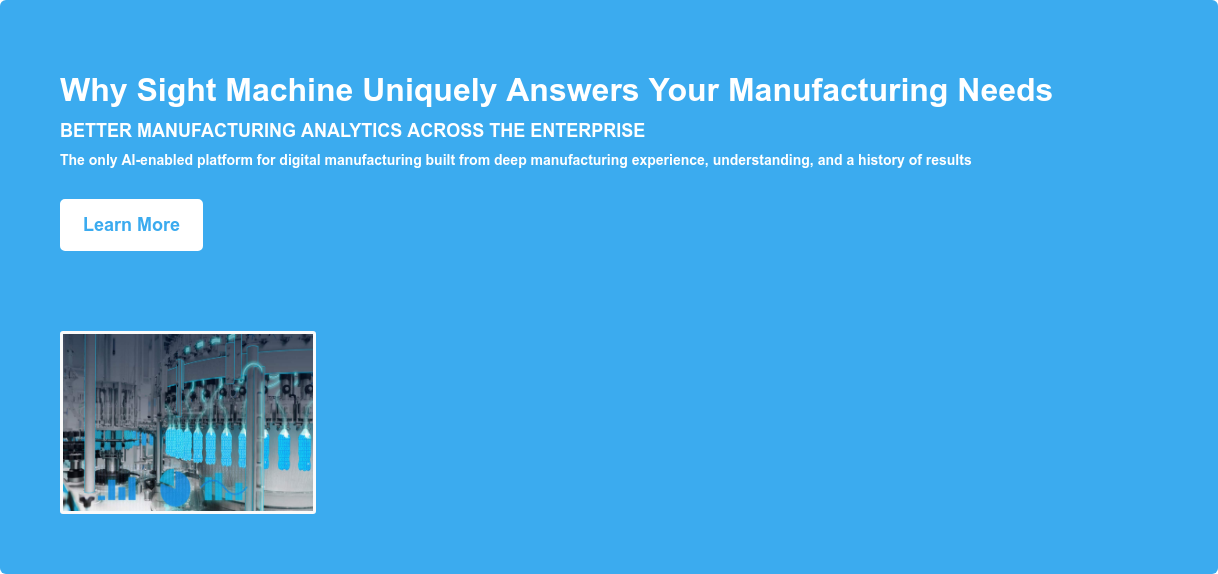Why Harnessing AI is Key
There is no shortage of discussion these days about the digital initiatives in Manufacturing 4.0, IoT, the Digital Transformation journey, and other forward-looking concepts. It’s all very heady and exciting — way up in the clouds, both metaphorically and quite literally in terms of IT infrastructure.
With so many futuristic ideas and buzzwords swirling around, it’s helpful to bring the discussion back down to earth. Let’s drill a little deeper and explore where things actually stand, what the challenges are, and where solutions can be found.
What is the state of manufacturing data today? Let’s start with some good news:
Congratulations! You’re Already Digitized
The goal of gathering shop floor data from processes, machines, and robots has largely been achieved over the past few years. With an abundance of real-time production data streaming in daily, manufacturers would be well-advised to tackle the next priority: understanding their existing data landscape and learning how to make it useful. Because unfortunately, manufacturing data is not yet driving significant business impact. Why is this so?
Enormous Volumes of Data… But Very Little to Show for It
The real challenge is that digital initiatives in manufacturing data and the technology surrounding it are fragmented and siloed. Each variety of data comes in its own format and structure, and resides in a specialized system that doesn’t talk to its many counterparts. As a result, most inputs can’t be retrieved in real time. Only a tiny fraction of data is readily accessible, and it takes hours or days. Some manufacturers have aggregated various inputs into a cloud-based data lake. But with other data still siloed on the shop floor, the end result is more akin to a data swamp.
Create a Unified Data Model
To be rendered useful, your diverse data sources — IoT sensors delivering real-time streams, raw materials data, quality input, and energy consumption data — must be stitched together. Barriers need to be broken down so information can be blended, unified, and correlated. This is easier said than done, with volumes in terabytes and variables in the hundreds to tens of thousands. Even if you could hire an army of data scientists, they couldn’t possibly meld everything together in anything close to real-time. After all, data scientists are only human. But AI isn’t.
The Importance of Leveraging AI
Mammoth data projects — involving oceans of input and thousands of variables — are precisely what AI and machine learning were invented for. Leverage these technologies to clean, blend, and interrelate your diverse data sources, and model them into a digital replica of your entire manufacturing process: a “digital twin.” With your data universe unified and modeled in this way, you can then turn advanced algorithms loose. Drilling down to specific machines, processes, and parts, sophisticated analysis techniques will reveal solutions to critical questions that had previously remained unanswered.
Of course, you’ll need the help of an analytics or IoT platform that can do all this, such as Sight Machine, an AI-driven application that is already achieving key results for manufacturers across industries.
To recap: Unify your data, model all of production, and analyze away. That’s the prescription. Now, how do you go about applying it? Where do you even begin?
Start small. Begin with one production line or plant, and determine the goals you’d like to achieve with data. Reducing your scrap rate could be one. Optimizing preventive maintenance might be another. You may want to finally pinpoint the root causes of troublesome recurring outages. Or determine optimum machine settings to generate uniform product quality. These are just examples; choose your own objectives based on your most pressing issues and needs.
Once you have a plant and a plan, deployment won’t take an army of consultants. Neither will it take years to realize value. A small team working smartly and steadily can achieve demonstrable and dramatic outcomes in a few weeks or a few months at most.
Learn fast. With evidence-based results arriving so quickly, implementation can be just as rapid. Working from a single source of truth — a comprehensive model encompassing all operational inputs — everyone from plant directors, line supervisors, process engineers, and operators can immediately start learning, adjusting, and iteratively fine-tuning their processes and procedures based on what the data has revealed.
Scale up quickly. Once you’re past the single-plant POC stage, it’s important to quickly replicate implementation across facilities. You want to get all of them on the same technology, and the same version. Here too, the Sight Machine platform is an excellent choice, as it’s engineered for rapid multi-factory deployment.
Now Is the Time
The great majority of manufacturers have yet to put production data to work to drive tangible impact. To hark back to our examples, too many outages still occur, scrap rates could be lower, and numerous pesky operational problems remain unsolved. Of course, even with all this, your company may still be doing quite well financially. To which I’d observe that now — when profits and performance are strong — is the best time to embrace digital initiatives in Manufacturing 4.0 and start turning your data into business value. In this era of economic uncertainty, no one knows for sure what the future may bring. But odds are excellent that the new business value you build today will be the engine that powers your prosperity and growth tomorrow.







